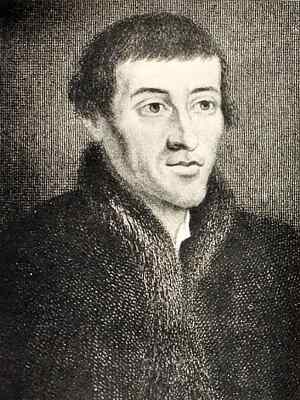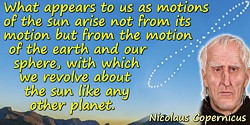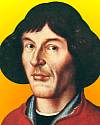 (source)
(source)
|
Nicolaus Copernicus
(19 Feb 1473 - 24 May 1543)
Polish astronomer who proposed the heliocentric model of the Solar System in which all the planets orbit around the sun at the centre.
|
NICOLAUS COPERNICUS
from Famous Men of Science (1926)
by Sarah K. Bolton
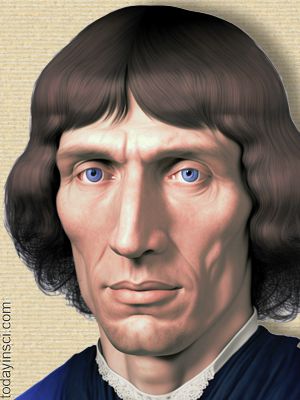
Imaged by todayinsci.com applying Artificial Intelligence using extant portraits
[p.1] Carlyle once remarked that the history of the world is the history of its great men; one might with equal truth state that the history of astronomy is a record of the lives of the great astronomers. Just who was the first astronomer must remain forever unknown;1 but it is certain that in the very beginning of mankind astronomy received attention. And the reason is not far to seek: some knowledge of the subject was necessary to fix the dates for the celebration of the various fasts and festivals—a matter of paramount importance throughout medieval times. It is probable that all the early scientists studied the heavens merely as a side line. Thus, Aristotle, who exercised such a profound influence in this branch of learning, was both an all-round scientist and a philosopher. Claudius Ptolemy, one of the most famous of the ancient astronomers, was an Egyptian king, who reigned at Alexandria between 127 and 157 a.d. [p.2] and Scriptures that it remained absolutely unquestioned for fourteen hundred years, and when Nicolaus Copernicus, himself many things besides an astronomer, became satisfied that the theory was false, he yet dared not denounce it for a long time, knowing full well the charges of heresy which would engulf him. The proclamation and proof of his discovery ushered into the world a new era of philosophical belief, and today to be the Copernicus of any movement is at once to align oneself with honesty and freedom of thought, mind, and conscience, the while paying tribute to an old monk who lived a life of solitude in the monastery gardens at Frauenburg some four centuries ago.
Nicolaus Copernicus was born in the town of Thorn, on the Prussian frontier, February 19, 1473. His father was a successful tradesman; his mother was a sister of Lucas Watzelrode, Bishop of Ermeland—a relationship which proved very advantageous to the nephew when he had attained man’s estate and begun to exercise indications of a great mind and unusual research abilities.
But little is known of the youth Nicolaus, beyond the fact that he seems always to have been of a sober turn, taking naturally to books and absorbing Latin and Greek as readily as a sponge does water. We are told that his education was carried on at home until he was able to enter the University of Cracow, with the idea of training for the medical profession. Here, however, an aptitude for mathematics and natural philosophy was uncovered, and shortly Nicolaus was so deep in all three subjects that a fourth needs must be developed to carry the others to completion, and he became an expert draughtsman.
Having graduated from Cracow in both arts and medicine, he set himself up in Rome as an earnest mathematician and astronomer, and was soon so well and favorably known that he was honored by the offer of the chair [p.3] of mathematics in the University of Rome. But he was not long to occupy this position. His uncle, the Bishop of Ermeland, had kept a gratified eye upon the young man’s progress, and now desired to have him identified with the homeland; so he offered him the canonry of the cathedral at Frauenburg.
Believing that some further preparation was necessary for the successful fulfillment of this trust, Copernicus entered the medical department of the University of Padua, where he remained until 1505, and then was stationed at the palace of Heilsberg for further preliminary service as the Bishop’s private physician. Here he found life far from a bed of roses. Resenting what in modern parlance would be considered “his pull,” envious folks did all in their power to make matters unpleasant for the young prebendary-to-be. Such was the natural gentleness of Copernicus, his love of peaceful solitude, and his unquestioned scholarship, however, that animosity could not endure, and on his uncle’s death he found himself in unquestioned possession of the canonry, and held in deepest reverence and respect. Here he fell into a daily round which was characteristic of the mathematical man of precision: Carefully dividing his time into thirds, he gave his day (1) to devotional exercises and diligent performance of his divine duties; (2) to charitably tending the sick poor in need of medical attention; (3) to the pursuance of his hobby—the study of astronomy and philosophical meditation.
That Copernicus wielded no small influence among his parishioners is proved by the fact that he was frequently called upon for advice in affairs of state, and though he never went out of his way to seek political honors, he was always ready and willing to give from his store of wisdom and learning for the benefit of his country. Thus, when the many wars shook the financial standards and [p.4] the Diet could not satisfactorily settle the question of money, a committee of senators was appointed to investigate affairs, and in turn, owning themselves powerless to cope with the problem, appealed to Copernicus. He set himself at once to the gigantic task, and presently evolved a plan for reducing to a definite standard the various moneys then in circulation in the provinces of the kingdom, at the same time getting out a valuable circular on money generally. His pamphlet was eagerly published, and his plan immediately adopted by the senate, who gratefully inserted it in their public Acts.
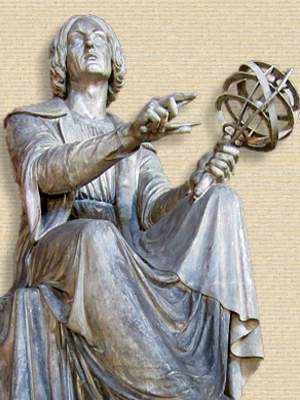
holding armillary sphere and open divider
by Bertel Thorvaldsen (1770-1844), Danish sculptor,
in Thorvaldsen Museum, Copenhagen.
Photo credit: Felix Wong CC BY-SA 4.0 (source)
One of the chief instruments in the modern observatory is a transit telescope. It is so mounted that it can swing only on the plane of the meridian, and therefore, sooner or later in the course of every twenty-four hours, all stars must cross its path, the time of their so doing being of particular moment in determining certain astronomical data. Copernicus had no transit instrument, in fact, he had no notion whatever of a telescope of any kind, as the invention of this important device did not occur until more than seventy-five years after his demise. But in the days of the old monk as now, necessity was the mother of invention, and the mind of Copernicus was quite equal to coping with the problem: he had slits cut in the walls of his observation room, and by placing himself suitably, was thus enabled to note the transit of the stars across a prescribed meridian. Further, by means of a quadrant of his own making, he succeeded in measuring the altitude of various stars above the horizon.
From the very first, Copernicus was interested in the movement of the planets, and the tables which he compiled were accounted the best of his times, and remained in use long after he himself had passed away. In making some special studies of the planet Mars, the old monk was much impressed by the variability of the brightness [p.5] and magnitude of this planet at different times. Why was this? He turned to the Ptolemaic system for the answer. Briefly speaking, this theory held the earth to be immovable, and that the planets, sun, moon, and stars, while not exactly revolving directly around it, yet revolved around imaginary points which in turn revolved round the earth in a circular path known as the deferent circle. The whole comprised a most complex puzzle which few rightly understood, and the more Copernicus pondered the less satisfied he became. Was it possible that Nature who always did things by the simplest methods had concurred in this ponderous scheme of circles? Had he not been so deeply religious, it is probable that, like Alphonso X, King of Castile, Copernicus might have felt that, if the theory were true, had he been “consulted at the Creation he could have given some useful hints!
Instead, his dissatisfaction only made him doubt the more, and he turned to the records of science for support in what he considered must be the real facts of the case, viz; that the sun and not the earth was the center of our solar system, and that it was the rotation of the earth on its axis which caused day and night, and the revolution of the earth about the sun which brought about the change of the seasons. Others he soon found had set forth much the same belief. Two thousand years before, Pythagoras, a Greek philosopher, had voiced the opinion that the sun was the center of the planetary system, and one of his followers, Aristarchus, who lived some four hundred years before Ptolemy, had suggested the rotation of the earth to account for the diurnal motion of the heavens. Both, however, had been overborne by Aristotle and Ptolemy, who had contrived to get their own strong beliefs backed by the Roman Church. It was preposterous, Ptolemy had held, to think of the earth in rotation. If such were the case, the rush of atmosphere [p.6] would sweep men off the surface. Copernicus answered in his own mind by saying that the inhabitants would be carried by the earth in the same manner as a man carries his overcoat. Besides, would it not be much simpler for the earth, along with the other planets, to revolve round the sun, in an orbit between Venus and Mars, than for the whole system of intricate circles to revolve round the earth? If his supposition were correct, he added, Venus and Mercury should exhibit phases like the moon. But this point was not established until after Galileo's invention of the telescope had clinched the Copernican theory beyond a doubt.
How long Copernicus was convinced of his theory before he communicated it to others is a matter of some conjecture. He found difficulty in breaking away from the “circle-worship” of the old philosophers. Besides, who was he to voice an opinion so contrary to the Church and all established belief? Someway, however, a hint leaked out, and men of science, flocking to Frauenburg to learn the truth, went away fully satisfied that Copernicus had the right of the matter.
But still the old monk could not be persuaded to put his theory into print for the benefit of the world at large. Some of his reluctance was no doubt due to his strong loyalty to the Church and to his general retiring disposition ; he disliked argument and controversy, and had small heart for facing all the stigma which would be attached to him for heresy. Besides, though he was entirely sure of the facts of the case, a good deal was based on supposition; he could not prove his theory, much less make a satisfactory diagram of the sun and planetary system: his head was muddled with epicycles—in those days it was thought that all motions must be compounded of circular ones, and he could not get clear from Ptolemy’s idea of a deferent circle. It remained for Kepler in the [p.7] next century to make a clean sweep of the complicated system of circles and substitute for it the simple ellipse.
The great achievement of Copernicus, therefore, was that he served to put the earth in its proper place in the cosmic scheme. While others before him had opined that the sun was the center of things, this was of no particular moment, since they had failed in establishing their belief and even the record of it was well-nigh obliterated. In an age when the Church enforced its creed with an iron rigidity of discipline, Copernicus dared to take an opposing line, and to stand so firmly by his convictions before all those who challenged him, that eventually “Aristotle worship,” which had impeded scientific progress for so many centuries, was effectively broken up, and the world emerged on a plane of free thinking that betokened the opening of a new era in things scientific.
And it was “The Revolution of the Celestial Orbs,” the book in which Copernicus explained his theory, which ushered in this great dawn. For thirteen years the MS. had been ready, but now the author was too frail and full of years to undertake its publication, and it was accordingly taken to Nuremburg by his young friend and pupil, Rheticus, who won much distinction by the able manner in which he edited the work. But, such is the irony of fate, that while the first copy was on its way to the author, a paralytic stroke laid him low, and the book, the fruits of his long life, reached him only a few hours before his death, which occurred in his seventieth year. Copernicus was now beyond the power of the Church, but he had left behind a masterly plea in the shape of a “dedicatory note” to Pope Paul III, which was most pleasantly received by that dignitary:
“If there be some who, though ignorant of all mathematics,” he wrote, “take upon them to judge of these, and dare to reprove this work, because of some passage of [p.8] Scripture, which they have miserably warped to their purpose, I regard them not, and even despise their rash judgment. . . . What I have done in this matter, I submit principally to your Holiness, and then to the judgment of all learned mathematicians. And that I may not seem to promise your Holiness more concerning the utility of this work than I am able to perform, I pass now to the work itself.”
As for that work, the scientist of today who has been used to reverence the name of Copernicus learns with surprise “how much of error, unsound reasoning, and happy conjecture” the pages comprise. It remained for Kepler, Galileo, and Newton to rectify the blunders and mature the general theory. In the meantime, Copernicus was laid to rest in the Cathedral of Frauenburg, and so little was his service then appreciated that no mention of his great discovery was made on his tombstone, and indeed not until thirty years thereafter was any memorial erected to his memory.
Copernicus was a man of many talents, not the least of these being that he was an artist of considerable repute. In his early days, he painted a half-length portrait of himself, which later fell into the hands of Tycho Brahe, the poet and astronomer, who delightedly placed it in his museum above the following clever inscription and eulogy:
Sublime in Air; the task to Earth he gives.
Amidst the world enthron’d he sits in State,
And bids the Heav’ns obey the Laws of Fate;
Yet thro’ all Nature is his Aid the same,
And changing Seasons still his Guidance claim.
Erratic Stars have now their Courses known,
By this rare System of the station’d Sun;
They stand, go retrograde, are swift, or slow,
Just as the Earth directs them what to do.
[p.9] The great Copernicus (the Man behold),
This heavy Orb in rapid Motion roll’d.
But why, you’ll say, was not his Wit portray’d?
But that is partly in the Heav’n display’d,
Partly in Earth; for neither can confine
The boundless Searches of his daring Mind.
Again you’ll say—But half his Figure’s shown,
A Man so worthy to be wholly known.
True; yet ’tis he who bore the Earth entire
Thro’ Space immense around the Solar Fire;
The spacious Earth in vain would hold the Man
Who measures Heaven with his ample Span.
- Science Quotes by Nicolaus Copernicus.
- 19 Feb - short biography, births, deaths and events on date of Copernicus's birth.
- The Book Nobody Read: Chasing the Revolutions of Nicolaus Copernicus, by Owen Gingerich. - book suggestion.
